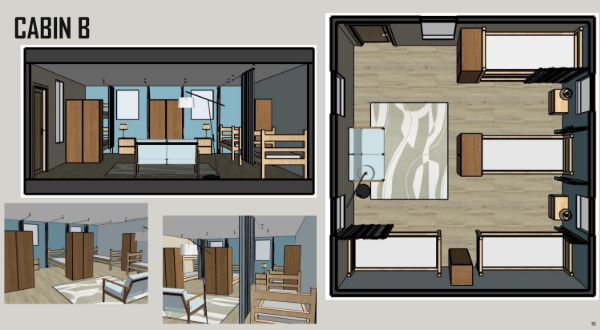Interior Design students propose renovations to CMU Biological Station cabins
Students completed a 6-week project focused on redesigning cabin interiors that prioritized functionality, cost-effectiveness, and client needs.
Nested along the beaches of Sand Bay, CMU’s Biological Station on Beaver Island provides courses, workshops, research opportunities and community events, offering a unique educational location for students and researchers. As part of an ongoing collaboration between the Interior Design program and campus partners to provide students with practical design experience and to support facility improvements, interior design students completed a renovation proposal project for the cabins located at the Biological Station.
Researchers and students who visit the Biological Station from May through September stay in various cabins located on-site, most of which have not been renovated in several years. Students in IND 436QR: Lighting Design, completed a 6-week project, focused on redesigning the cabin interiors—single-room and duplex layouts—for nine uninsulated cabins.
Under the direction of Julie Qun Zuo, 21 junior interior design students analyzed site conditions, studied client requirements, and created schematic designs. Students were tasked with renovating each cabin to enhance comfort, functionality, and the overall aesthetic, all while staying within a $2,000 budget.

Cabin B mockup by Janderwski and Davis.
For their cabin proposals, each group of students included their vision and goals. One concept statement by students Madison Janderwski (Bay City, MI) and Hannah Davis (Caro, MI) read, “The cabin will balance practicality and comfort using lighting to support both task-oriented activities and ambient mood; employing a lighting and design strategy that fosters a sense of personal space within the shared cabin that encourages both rest and community.”
Students Elena Piccolo (Roscommon, MI) and Makenna Schneider (Saint Johns, MI) settled on a design that promotes natural warmth and relaxation while keeping an open and breathable concept. Using colors such as cool dusty blues and warm woods, this would allow for feelings of comfort while remaining open and airy.

Students presented their final proposals to Dr. Kevin Pangle, Director of the Biological Station, and Professor Tanya Domina, Chair of the Department of Fashion, Interior Design and Merchandising, on October 1 and 2, 2025.
According to Zuo, this project was a great opportunity for students to combine their design skills with problem-solving solutions and apply them to a real-world challenge—complete with an authentic site, client needs, and a limited budget. “Their proposals are not only creative, but also practical, and effectively addressed real user needs,” said Zuo, who is very pleased with the proposals from students in the class. “We received very positive feedback from the client, and it’s rewarding to see our students’ work contribute meaningfully to the CMU community and the future of the Biological Station.”
To learn more about the Interior Design program at CMU, visit their program page.




